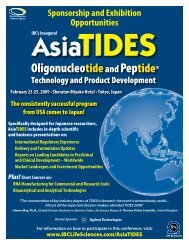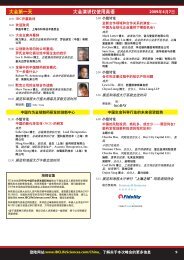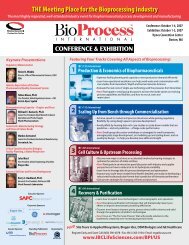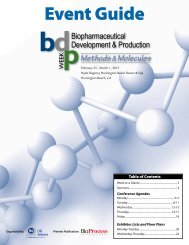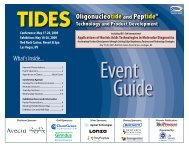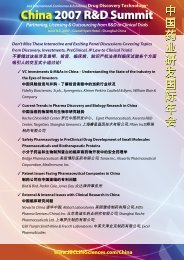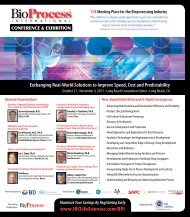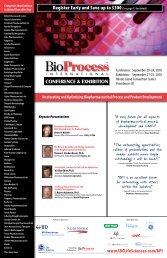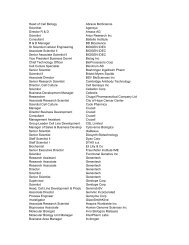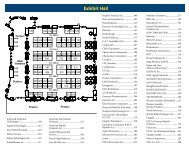The Finalists - IBC Life Sciences
The Finalists - IBC Life Sciences
The Finalists - IBC Life Sciences
You also want an ePaper? Increase the reach of your titles
YUMPU automatically turns print PDFs into web optimized ePapers that Google loves.
THE FINALISTS<br />
UPSTREAM<br />
DOWNSTREAM<br />
MANUFACTURING
As a proud sponsor of the<br />
2012 BioProcess International Awards,<br />
ATMI would like to congratulate all finalists on<br />
their outstanding achievements.<br />
Integrity Single-Use Bioprocessing Solutions<br />
www.atmi-lifesciences.com
Welcome to the<br />
2012 BioProcess International Awards —<br />
Honoring a Decade of BioProcess!<br />
HONORING A DECADE OF BIOPROCESS2012<br />
As we approached BioProcess International’s tenth year of publication (2003–2012),<br />
we paused to reflect and gain a clear perspective on how scientific advancements,<br />
revolutionary new technologies, ground-breaking partnerships, collaborations,<br />
and individuals had dramatically changed and ultimately improved how the biotechnology<br />
industry develops, manufactures, and delivers life-changing medications to a global population.<br />
From that consideration, we decided to create an inaugural BioProcess International Award Program to recognize<br />
and celebrate those outstanding technologies, technical applications, collaborations, and thought leaders that,<br />
over this past decade, have had the greatest positive impact on each of the “three pillars” of bioprocessing:<br />
Upstream Processing, Downstream Processing, and Manufacturing.<br />
In January 2012, BioProcess International introduced the 2012 Awards program and opened nominations to<br />
the industry through a secure online site. Nominations remained open through 30 June 2012. Each submitted<br />
nomination was transferred to an individual ballot form. We consolidated those ballots by pillar and electronically<br />
sent them in batches to judges we had selected based upon their unique expertise. <strong>The</strong>y received ballots containing<br />
only an entry number and an ID number unique to each submission. Each judge scored the separate narratives<br />
(answers to four or five questions, depending on the category) in a ballot on a scale from 1 (low) to 5 (high)<br />
and sent it directly to Deloitte & Touche LLC. <strong>The</strong> auditors worked with us at every step to ensure that the ballots<br />
arrived in proper format. <strong>The</strong> firm then certified and compiled those scores and sent BPI lists of the top three<br />
scorers for each category within the three pillars. To confirm impartiality, each judge submitted a signed statement<br />
that he or she had scored the nominations fairly and impartially according to the set guidelines.<br />
Now, BioProcess International is proud to formally introduce the 36 BioProcess International Award finalists for<br />
2012. This exclusive group represents the very best technologies, applications, collaborations, and thought leaders<br />
that the bioprocessing industry has to offer.<br />
On 9 October 2012, BioProcess International will host a special reception and ceremony to honor all those finalists<br />
and recognize the 12 award winners. We hope you will join us at the awards ceremony taking place at our annual<br />
conference in Providence RI, 8-12 October 2012, as we begin the journey together into the future of our industry.<br />
Brian J. Caine<br />
Publisher<br />
S. Anne Montgomery<br />
Editor in Chief<br />
Special thanks to our Exclusive Sponsors<br />
And our Supporting Sponsor
<strong>The</strong> Upstream Processing Pillar<br />
<strong>The</strong> Upstream Processing pillar recognizes technologies, partnerships, and<br />
innovative thinking that contributed to dramatically improved production<br />
titers and reduced overall costs and capacity requirements. Over the past<br />
10 years we have seen the biopharmaceutical industry transformed by<br />
these innovations. Vaccines have experienced a renaissance thanks to<br />
recombinant technologies, and cell and gene therapies are now poised to<br />
enter the market — if their developers can learn from the experiences of<br />
those who have come before. Sophisticated approaches to process design<br />
enable process modeling, and quality-by-design initiatives promote new<br />
ways of looking at process design and validation. Meanwhile, single-use<br />
technology is changing the look, feel, size, and functionality of bioprocess<br />
facilities around the world.<br />
<strong>The</strong> finalists in this pillar reflect many of the trends identified here,<br />
highlighting single-use technologies, perfusion culture, cell-line genomics,<br />
vaccine production for pandemic preparation, and engineering approaches<br />
to upstream process development.<br />
E x c l U s i v E s P o n s o r<br />
ATMI <strong>Life</strong><strong>Sciences</strong> provides the Integrity line of<br />
single-use bioprocessing and fluid-handling solutions to the<br />
biopharmaceutical, vaccine and cellular therapy industries.<br />
ATMI provides worldwide supply chain security, integratable<br />
single-use technologies, integratable units of operation and<br />
ongoing innovation to increase process efficiencies for<br />
the lifesciences industry.<br />
2012 BioProcess i nternational awards
Technology of the Decade — <strong>The</strong> <strong>Finalists</strong><br />
Technology:<br />
Company:<br />
<strong>The</strong> WAvE Bioreactor: An Early Disruptive Technology<br />
GE Healthcare<br />
<strong>The</strong> WAVE Bioreactor was the world’s first truly single-use bioreactor. With its<br />
introduction in the mid 1990s, the landscape of cell culture from lab to production<br />
scale began to change dramatically. It was the first GMP-ready technology for<br />
single-use manufacturing. By the time BPI published its first single-use supplement<br />
in 2004, this bioreactor had already paved the way for a prolonged revolution in the industry’s approach<br />
to manufacturing. Today, single-use bioreactors are the default choice for seed train and clinical<br />
manufacturing operations. <strong>The</strong> proliferation of single-use technology continues to be aided by the wide<br />
success of this pioneering design.<br />
<strong>The</strong> Technology<br />
of the Decade<br />
Award recognizes<br />
game-changing<br />
innovations in<br />
equipment,<br />
raw materials<br />
and/or tools<br />
that significantly<br />
transformed drug<br />
development and<br />
manufacturing,<br />
improving process<br />
efficiency and<br />
accelerating<br />
market entry.<br />
Technology:<br />
ATF (Alternating Tangential Flow) system<br />
Company:<br />
refine Technology<br />
<strong>The</strong> ATF System is based upon the technology of alternating tangential<br />
flow, generated by a diaphragm moving upward and then downward within a pump head, connected<br />
to a filter housing, and usually attached to a standard bioreactor. Its ability to generate high flows with<br />
low shear offers many benefits for cell culture, including cleaning of the filter surface and supporting<br />
growth to high cell concentrations in a number of cell lines. A key business deliverable is repeatable<br />
delivery of high cell concentrations in all bioreactors, including at scale. Cost savings are chiefly from<br />
reductions in numbers/sizes of bioreactors needed.<br />
Technology:<br />
<strong>The</strong> First single-Use, stirred-Tank cell culture Bioreactor (sUB)<br />
Company:<br />
<strong>The</strong>rmo scientific<br />
<strong>The</strong> first commercially available stirred-tank cell culture bioreactor was<br />
launched in early 2006 by HyClone (now <strong>The</strong>rmo Scientific). At the time of its introduction, other<br />
disposable bioreactor technologies were limited to smaller-scale production. <strong>The</strong> SUB scalability and<br />
range of sizes met the needs of traditional mixing, from 25 liters to 2,000 liters. <strong>The</strong> true innovation<br />
is the sophisticated single-use “bag” part of the system, wherein all traditional bioreactor functions<br />
are incorporated but with single-use surfaces, including sparging, agitation, sampling, monitoring,<br />
harvesting, and supplementing. <strong>The</strong> SUB further revolutionized acceptance of disposables in upstream<br />
processing, driving penetration of single-use products into the cell culture market.<br />
UPSTREAM<br />
Honoring a decade of BioProcess
<strong>The</strong> Technical<br />
Application of<br />
the Decade<br />
Award recognizes<br />
user companies’<br />
successful<br />
adoption and<br />
implementation<br />
of game-changing<br />
processes and best<br />
practices resulting<br />
in improved<br />
approaches to<br />
process design,<br />
development, and<br />
manufacturing.<br />
Technical Application of the Decade — <strong>The</strong> <strong>Finalists</strong><br />
Technology:<br />
Company:<br />
optimizing cell retention Using Perfusion cultivation<br />
Bayer Healthcare cell culture Development Group (Us)<br />
and Bayer Technology services (Germany)<br />
Perfusion cultivation of mammalian cells can be used with complex and unstable<br />
biotherapeutics such as rFVIII that cannot be manufactured using a traditional fed-batch<br />
approach. Full-length rFVIII is the largest and most complex biopharmaceutical in the<br />
market today, with 20 N-linked and at least 7 O-linked glycosylation sites. In addition,<br />
rFVIII is highly unstable: Exposure to cell culture temperatures of 37 °C results in ~50%<br />
reduction in activity in less than 24 hours. <strong>The</strong> perfusion process honored here was designed at Bayer<br />
to produce this highly complex and unstable molecule with the correct glycosylation profile.<br />
Technology:<br />
Company:<br />
implementation of scalable, Disposable 10-ml<br />
Bioreactors into r&D<br />
GlaxosmithKline and Pfenex, inc.<br />
Microbioreactor technologies (using the disposable Micro-24/Cellerator<br />
by Microreactor Technologies, now Pall Corporation) and applications<br />
were developed for microbial and mammalian expression systems.<br />
Implementation of scalable, disposable 10-mL bioreactors into R&D was unknown before Tiffany Rau<br />
and Torben Bruck innovated and redefined the next generation of strain/clone selection and process<br />
development. <strong>The</strong> system and applications are used to screen cell lines and conduct process development<br />
and DoE experiments to improve selection of the “right” strain/clone and process. This work also celebrates<br />
how microbial and mammalian worlds came together to deliver the next generation of tools and processes.<br />
Technology:<br />
single-Use Technology for Production of Bacterial Proteins<br />
Company:<br />
<strong>The</strong>rapeutic Proteins international, llc<br />
UPSTREAM<br />
Sarfaraz Niazi developed and implemented a unique single-use technology<br />
for upstream production of bacterial proteins in a flexible bags. <strong>The</strong> design<br />
incorporates significant modification of the flexible pillow bags popularized by<br />
the WAVE technology to allow instant oxygenation and large exhausts. <strong>The</strong>y are kept stationary to reduce<br />
stress on bag seams. It enables the company to perform upstream and downstream operations in the<br />
same flexible bioreactor for large-scale GMP production of bacterial and mammalian cell proteins.<br />
This technology saves millions of dollars of capital cost and substantial process cost of manufacturing<br />
and assures the highest degree of regulatory compliance.<br />
2012 BioProcess international awards
collaboration of the Decade — <strong>The</strong> <strong>Finalists</strong><br />
Project:<br />
Company:<br />
Project:<br />
Company:<br />
Worldwide supply and Distribution Agreements<br />
to Develop novel Filtration systems<br />
refine Technology, GE Healthcare,<br />
and sartorius stedim Biotech<br />
Refine Technology’s objective is to dramatically reduce the risk and cost of upstream<br />
processing through continuous culture and process intensification. To that end, the<br />
company signed a worldwide supply and distribution agreement with GE Healthcare,<br />
which supplies hollow-fiber filtration cartridges for use with Refine’s ATF system<br />
for perfusion cell culture. Additionally, Sartorius Stedim Biotech and Refine<br />
Technology collaborated toward developing a robust platform for high-density perfusion cell cultivation,<br />
enabling fast and easy connection of the ATF System to SSB’s single-use BIOSTAT® bioreactors.<br />
SSB and Refine provided users with initial application and protocol guidance for these connections.<br />
Genomic sequencing of the chinese Hamster Genome Database<br />
cHo Genome User Group,<br />
www.chogenome.org<br />
This large collaboration of companies and researchers produced the<br />
draft genomic sequence of the CHO-K1 ancestral cell line: 2.45 Gb of genomic sequence with<br />
24,383 predicted genes. CHO-derived immortalized cell lines are the preferred host system for therapeutic<br />
protein production, but previous progress was made without availability of genomic sequences. <strong>The</strong><br />
annotated public genome sequence for a CHO cell line represents another tool in the bioprocessing toolbox,<br />
providing genome-scale science for optimizing biopharmaceutical protein production. It facilitates targeted<br />
genetic manipulations, helps elucidate poorly characterized phenotypes, and allows for comprehensive<br />
deployment of “-omic” tools for CHO-K1 and related cell lines.<br />
<strong>The</strong> Collaboration<br />
of the Decade<br />
Award<br />
recognizes industry<br />
alliances and<br />
collaborations<br />
whose innovative<br />
partnerships<br />
dramatically<br />
transformed<br />
stand-alone<br />
technologies.<br />
<strong>The</strong>se<br />
collaborations<br />
resulted in<br />
overall process<br />
cost reduction<br />
while creating<br />
new, effective<br />
approaches to<br />
biopharmaceutical<br />
design,<br />
development,<br />
and manufacturing.<br />
Project:<br />
xcellerex AMP Program Team (DArPA – AMP)<br />
Company:<br />
xcellerex inc., Pfenex, inc., deltaDoT, ltd.,<br />
Biopharm services, inc., and the latham BioPharm Group<br />
In 2007, the US Defense Advanced Research Projects Agency (DARPA) launched<br />
an ambitious program, Accelerated Manufacture of Pharmaceuticals (AMP),<br />
aimed at developing ultrafast biomanufacturing technologies. <strong>The</strong> Xcellerex AMP<br />
collaboration resulted in a high-efficiency bacterial expression system to produce<br />
a model vaccine and antibody. <strong>The</strong> Pfēnex expression technology is based on<br />
Pseudomonas fluorescens, which expresses recombinant proteins at high titers.<br />
<strong>The</strong> system has developed a strong track record in producing a number of different<br />
types of complex molecules including vaccines, virus-like particles, engineered proteins<br />
such as scaffolds, and antibody derivatives in addition to fully assembled MAbs.<br />
UPSTREAM<br />
Honoring a decade of BioProcess
<strong>The</strong> Thought<br />
Leader of the<br />
Decade Award<br />
recognizes an<br />
industry visionary<br />
whose work,<br />
accomplishments,<br />
and reputation are<br />
remembered as<br />
being a catalyst<br />
for change; who<br />
is universally<br />
regarded as<br />
an instrument<br />
of change and<br />
instruction; and<br />
who developed,<br />
championed, and<br />
implemented<br />
best practices,<br />
while encouraging<br />
humanitarian/<br />
philanthropic<br />
efforts.<br />
Thought leader of the Decade — <strong>The</strong> <strong>Finalists</strong><br />
Name:<br />
Parrish Galliher<br />
Technologist and Entrepreneur<br />
<strong>The</strong>re are technologists who come up with great ideas and entrepreneurs who<br />
found companies to develop technologies. Parrish is a rare individual who<br />
does both. He made significant personal and professional sacrifices to forward<br />
his vision of a truly modular disposable facility, one powered by a large-scale<br />
single-use bioreactor. He took on substantial risk to found Xcellerex based on his<br />
unwavering belief in this manufacturing approach. In promoting the industry’s<br />
move to single-use reactors, he has helped companies save significant time and<br />
money in development and manufacturing of important biologics. Xcellerex’s<br />
recent purchase by GE should further enhance this “revolution.”<br />
Name:<br />
chetan T. Goudar<br />
A champion of systems Biology<br />
Goudar worked at Bayer HealthCare over the past decade, responsible for<br />
developing robust cell culture processes for new biologics and producing<br />
material for preclinical and phase 1–3 clinical trials. Since 2002 he championed<br />
adaptation of a systems biology approach toward cell culture development.<br />
This started with work on quasi-real-time metabolic flux analysis in 2002,<br />
followed by work on 13C-glucose flux analysis using 2D-NMR, gene expression<br />
profiling using cross-species hybridization, application of metabolomics to<br />
industrial-scale mammalian cultures, and recently, the completion of the effort<br />
to sequence the baby hamster kidney (BHK) genome. He joined Amgen as<br />
Director, Cell <strong>Sciences</strong> and Technology in May 2012.<br />
Name:<br />
Jerold Martin<br />
industry spokesperson and single-Use champion<br />
UPSTREAM<br />
Jerry has been a stalwart, consistent, loyal spokesperson for the biopharma<br />
industry since before many of the current experts in the field were born.<br />
His knowledge transcends partisanship. He volunteers his time, energy, and<br />
resources to committees, conversations, and industry dialogs. He doesn’t judge<br />
people based on what they can do for him, but rather on their commitment,<br />
honesty, and the merits of their contributions to the industry and society. As<br />
one of the founders of the Bio Process Systems Alliance (BPSA), he has been a<br />
major champion for the adoption of, and guideline development for single-use<br />
technologies.<br />
2012 BioProcess international awards
<strong>The</strong> Downstream Processing Pillar<br />
<strong>The</strong> Downstream Processing pillar recognizes technologies, partnerships,<br />
and innovative thinking that help the bioprocessing industry recognize,<br />
address, and overcome what many have labeled as the looming<br />
“downstream bottleneck.” When BPI’s first decade began, a fairly mature<br />
industry was working through a crisis in manufacturing capacity, and dire<br />
predictions of an industry-wide downstream bottleneck soon occupied the<br />
pages of many trade publications. With increasing product titers coming<br />
from upstream production, existing downstream processes struggled to<br />
keep up. Under the pressures of time, competition, and dwindling resources<br />
in a stressed global economy, people working downstream are using quality<br />
by design and devoting attention to reducing their own process<br />
footprints, extending single-use, modularity, and other new technologies to<br />
increase flexibility and seeking to reduce the number of purification steps<br />
required.<br />
<strong>The</strong> finalists in this pillar reflect many of the trends identified here,<br />
with analytical instrumentation; inline buffer dilution; computational<br />
fluid dynamics; filtration advancements, virus filters, and high-capacity<br />
capture methods; new ligands and protein A improvements for affinity<br />
chromatography, and multimodal chromatography. Thought leaders stand<br />
at the forefront of quality-by-design implementation as well as operational<br />
excellence and development of single-use technologies.<br />
E x c l U s i v E s P o n s o r<br />
GE Healthcare <strong>Life</strong> <strong>Sciences</strong> provides products and expertise for<br />
developers and manufacturers of biotherapeutics to enable efficient,<br />
flexible and cost-effective approaches to characterization, expression,<br />
and purification of biomolecules. <strong>The</strong> company offers tools and<br />
support to take recombinant proteins, monoclonal antibodies, plasma<br />
proteins, oligonucleotides, and vaccines from research, through<br />
process development, to full-scale manufacturing.<br />
Honoring a d ecade of BioProcess
<strong>The</strong> Technology<br />
of the Decade<br />
Award recognizes<br />
game-changing<br />
innovations in<br />
equipment,<br />
raw materials<br />
and/or tools<br />
that significantly<br />
transformed drug<br />
development and<br />
manufacturing,<br />
improving process<br />
efficiency and<br />
accelerating<br />
market entry.<br />
Technology of the Decade — <strong>The</strong> <strong>Finalists</strong><br />
Technology:<br />
Company:<br />
<strong>The</strong> PlEx-iD system for rapid Microbial Detection<br />
Abbott laboratories–ibis Biosciences<br />
Initiatives such as QbD and PAT call for better control of manufacturing<br />
process to ensure final quality. Originally designed for biothreat and publichealth<br />
applications, the PLEX-ID system offers rapid, broad detection and<br />
identification of known and emerging organisms from multilocus base composition analysis.<br />
<strong>The</strong> genotypic system uses PCR amplification followed by MS detection to identify viruses, bacteria,<br />
or fungi within eight hours, direct from sample to results. <strong>The</strong> PLEX-ID system enables manufacturers to<br />
better control their process from cell banks to final products, guarding against virus contamination and<br />
ensuring rapid identification of excursions of adventitious agents.<br />
Technology:<br />
iBD inline Buffer Dilution systems<br />
Company:<br />
Asahi Kasei Bioprocess<br />
Increased protein titers from upstream processes require substantial quantities of diluted buffers for<br />
downstream processing. Introduced in 2007, IBD systems help manufacturers prepare 1× binary and<br />
ternary buffer blends from ≤20× salt-solution concentrates for purification. Process analytical technology<br />
controls pH and conductivity simultaneously, and large buffer tanks are replaced with disposable bags.<br />
<strong>The</strong> systems minimize batch variation and reduce the need to discard/reprocess buffers that fail required<br />
specifications. Direct cost savings come from reduced capital expenses for large-volume buffer hold<br />
tanks, reduced operating costs (offline buffer QC, tank cleaning, and cleaning validation), and improved<br />
turnaround times.<br />
Technology:<br />
Planova virus-removal Filters<br />
Company:<br />
Asahi Kasei Bioprocess<br />
DOWNSTREAM<br />
Planova virus-removal filters eliminate viruses from mammalian cell lines or human plasma during<br />
biotherapeutic production. Building on the success of the world’s first virus-removal filter (Planova<br />
35N, introduced in 1989), the family expanded in this past decade to include Planova 15N (the world’s<br />
first parvovirus removal filter) and Planova 20N, with respective mean pore sizes of 15 nm and 20<br />
nm. By combining robust performance with unique scalability, this family of filters accommodates<br />
development through commercial projects. <strong>The</strong> filters combine reliable, high-throughput filtration with<br />
maximum product recovery and virus retention, removing endogenous and adventitious viruses without<br />
compromising product viability.<br />
2012 BioProcess international awards
Technical Application of the Decade — <strong>The</strong> <strong>Finalists</strong><br />
Technology:<br />
Company:<br />
computational Fluid Dynamics (cFD)<br />
Amgen<br />
Amgen researchers used CFD to gain a fundamental understanding of fluid and mass transfer inside a<br />
large-scale packed chromatography column. <strong>The</strong>ir work fulfilled a need for insight into fluid flow and<br />
related phenomena to mitigate risks associated with process equipment scale-up. <strong>The</strong>y showed how<br />
CFD and other traditional techniques can be used to complement each other. <strong>The</strong> application enhances<br />
understanding of flow distribution and aids in fabrication/testing of large-scale chromatography columns.<br />
It facilitates new design features for reducing the risk of microbial contamination. Similar approaches<br />
to other downstream and upstream unit operations can help companies gain valuable process<br />
understanding.<br />
<strong>The</strong> Technical<br />
Application of<br />
the Decade<br />
Award recognizes<br />
user companies’<br />
successful<br />
adoption and<br />
implementation<br />
of game-changing<br />
processes and best<br />
practices resulting<br />
in improved<br />
approaches to<br />
process design,<br />
development, and<br />
manufacturing.<br />
Technology:<br />
optimization and scale-Up of Ultrafiltration/Diafiltration<br />
in clinical Manufacturing<br />
Company:<br />
Human Genome sciences<br />
Large amounts of a MAb drug are often required for sufficient therapeutic effect,<br />
but delivery is limited by subcutaneous injection volume. This experimental<br />
approach (published in 2008) focuses on optimization and scale-up of the<br />
ultrafiltration/diafiltration step in clinical manufacturing of a MAb formulation. <strong>The</strong> robust, scalable<br />
formulation step enabled production of clinical supplies at concentrations ≤183 mg/mL of protein.<br />
<strong>The</strong> team used Millipore’s Pellicon 2 tangential flow mini-cassette with Biomax polyethersulfone 50<br />
kDa membrane and C screen to examine the UF/DF process for ABthrax protein, a MAb in clinical<br />
development for neutralization of anthrax toxin.<br />
Technology:<br />
Development of a High capacity MAb capture step<br />
to replace Protein A<br />
Company:<br />
Percivia, llc<br />
Blanca Lain et al. concluded that Toyopearl GigaCap S-650M media can capture a monoclonal IgG1<br />
with ≥90 g/L dynamic binding capacity. <strong>The</strong>ir goal was to develop a high-capacity MAb capture step to<br />
replace protein A affinity chromatography. This approach can be used with other methods for commercial<br />
production of antibodies, addressing the challenge of improving downstream throughput of higher-titer<br />
MAb feedstocks — while reducing process costs. <strong>The</strong> high-capacity step using CEX chromatography<br />
captured MAbs from clarified harvests with a binding capacity of ≥90 g/L, ≥95% product recovery, and<br />
purity comparable to that achievable with protein A, including ≥95% HCP reduction.<br />
DOWNSTREAM<br />
Honoring a decade of BioProcess
<strong>The</strong> Collaboration<br />
of the Decade<br />
Award<br />
recognizes industry<br />
alliances and<br />
collaborations<br />
whose innovative<br />
partnerships<br />
dramatically<br />
transformed<br />
stand-alone<br />
technologies.<br />
<strong>The</strong>se<br />
collaborations<br />
resulted in<br />
overall process<br />
cost reduction<br />
while creating<br />
new, effective<br />
approaches to<br />
biopharmaceutical<br />
design,<br />
development,<br />
and manufacturing.<br />
collaboration of the Decade — <strong>The</strong> <strong>Finalists</strong><br />
Project:<br />
Company:<br />
new Affinity-ligand–Based chromatographic Media<br />
GE Healthcare and BAc Bv<br />
Since 2006, GE Healthcare and BAC have had an ongoing, successful collaboration<br />
to develop technologies for improving manufacturing efficiency. This has led to the<br />
commercial launch of seven products that are used in biomanufacturing worldwide.<br />
<strong>The</strong> work stemmed from BAC’s development of unique affinity ligands based upon<br />
camelid-derived single-domain antibody fragments. <strong>The</strong> collaboration brought this<br />
technology from research scale to the wider bioprocess community by delivering<br />
high-quality media based upon those antibodies. <strong>The</strong>se results show how open<br />
innovation can bring high-quality and fit-for-purpose products to the market in<br />
a short time frame.<br />
Project:<br />
creation of a GMP-compliant, reproducible,<br />
robust crystallization Method<br />
Company: University of Applied sciences Biberach, Boehringer ingelheim,<br />
rentschler Biotechnologie GmbH, and the Karlsruhe institute<br />
of Technology (KiT)<br />
In 2007, the BMBF (Bundesministerium für Bildung und Forschung) launched<br />
an initiative to fund development of new purification techniques in Germany.<br />
<strong>The</strong> interdisciplinary consortium honored here is coordinated by the faculty for<br />
pharmaceutical biotechnology at the University of Biberach. <strong>The</strong>y seek to create a<br />
GMP-compliant, reproducible, robust crystallization method for producing pure crystals<br />
in complex protein mixtures. Through this work, biologists, biochemists, chemists, and<br />
process engineers hope to learn how technical protein crystallization can be applied as a<br />
novel separation process for biopharmaceuticals, and antibodies in particular. Researchers<br />
suggest that it may become an acceptable alternative to affinity chromatography.<br />
Project:<br />
Genetically Engineered immunological constructs<br />
DOWNSTREAM<br />
Company:<br />
validated Biosystems, city of Hope Medical center’s Beckman<br />
research institute, and the crump institute for Molecular imaging’s<br />
Department of Molecular and Medical Pharmacology at<br />
UclA’s David Geffen school of Medicine<br />
Small, genetically engineered immunological constructs (minibodies) are being<br />
developed for a growing range of in vivo applications. <strong>The</strong>ir small size potentially gives<br />
them access to tissues that are poorly accessible by intact antibodies; rapid clearance<br />
from blood and nontargeted tissues; lower immunogenic response; and eye-drop,<br />
inhalant, and oral administration routes. This 2010 work describes new approaches to<br />
key challenges with early phase minibody purification process development. Using mixed<br />
modes in process chromatography has solved purification problems that traditional methods<br />
could not. A number of presentations and publications now suggest that process developers<br />
include mixed modes at early development stages.<br />
2012 BioProcess international awards
Thought leader of the Decade — <strong>The</strong> <strong>Finalists</strong><br />
Name:<br />
Günter Jagschies<br />
A visionary leader in Pursuit of industrial Excellence<br />
Jagschies challenges the status quo in the industry through thought-provoking<br />
analyses of the state of manufacturing, industry trends, and corporate<br />
strategies. Employed by one of the industry’s largest suppliers, he objectively<br />
pursues industrial excellence in biotechnology. His greatest skill is an ability to<br />
anticipate trends (e.g., the downstream bottleneck and advantages of single-use<br />
technologies) and stimulate discussion long before issues become problems.<br />
In open forums, he encourages others to rethink the status quo — to analyze<br />
problems as a system, rather than as a sum of individual parts, putting commercial<br />
interests aside for the greater good of the industry.<br />
Name:<br />
Duncan low<br />
Downstream Processing Pioneer<br />
<strong>The</strong> Thought<br />
Leader of the<br />
Decade Award<br />
recognizes an<br />
industry visionary<br />
whose work,<br />
accomplishments,<br />
and reputation are<br />
remembered as<br />
being a catalyst<br />
for change; who<br />
is universally<br />
regarded as<br />
an instrument<br />
of change and<br />
instruction; and<br />
who developed,<br />
championed, and<br />
implemented<br />
best practices,<br />
while encouraging<br />
humanitarian/<br />
philanthropic<br />
efforts.<br />
Low has been a pioneer of downstream processes. He leads cross-functional<br />
teams for materials and technology evaluation, technology development, and<br />
process analytical technology. He serves on the ISPE Executive Committee for PAT<br />
and USP’s Committee of Experts, and he chairs the ASTM E55.01 subcommittee<br />
to develop consensus standards for biomanufacturing. He has extensive<br />
experience with upstream and downstream processing tools and works closely<br />
with applications development. Over the past decade, he has shed light on the<br />
protein A purification step (among others), facilitating more efficient use of that<br />
technology and seeking ways to improve yields<br />
Name:<br />
Jerold Martin<br />
Driving Best Practices for single-Use Adoption<br />
Martin has been at the forefront of the introduction of integrated, validated,<br />
complete biomanufacturing systems, skillfully helping to translate needs and<br />
capabilities into ideas and products. He was a driving force behind adoption<br />
of large-scale filter capsules and advancements in tubing, sterile connectors,<br />
membrane chromatography, and process containers. Over the past decade, he has<br />
been a major proponent of single-use equipment especially, and his best-practice<br />
guides are widely adopted. He contributes regularly to educational, trade, and<br />
scientific efforts to promote disposables. He is a scientific visionary who has had<br />
an ongoing, significant, and positive influence on the biopharmaceutical industry.<br />
DOWNSTREAM<br />
Honoring a decade of BioProcess
Manufacturing Pillar<br />
<strong>The</strong> Manufacturing pillar recognizes technologies, partnerships,<br />
and innovative thinking that have redefined how and where biotech<br />
companies can effectively and profitably produce and distribute products<br />
at commercial-scale volumes. Ten years of BioProcess International have<br />
followed the increased globalization of the biotechnology industry.<br />
Harmonized regulations continue to address ways in which companies can<br />
enter multiple markets. Quality by design is enabling efficient and costeffective<br />
optimization of existing processes. Sponsors now have broader<br />
choices to make regarding where their products will be manufactured and<br />
marketed, and biotechnology hubs are becoming established around<br />
the globe. Regions of the Asia–Pacific are developing infrastructure to<br />
support work toward producing lower-cost drugs and vaccines to their own<br />
populations. And debate over the future of biosimilars/biobetters continues,<br />
as regulatory pathways continue to be mapped.<br />
<strong>The</strong> finalists in this pillar reflect the trends described here with new protein<br />
formulation concepts, fluid-management solutions and other single-use<br />
technologies, product characterization and information management,<br />
new product classes, automation applications, and novel partnerships and<br />
industry support. Thought leaders are experts in single-use technology,<br />
cost management, aseptic processing, contamination control, and risk<br />
management.<br />
E x c l U s i v E s P o n s o r<br />
<strong>Life</strong> Technologies Corporation is a global biotechnology company with<br />
customers in more than 160 countries using its innovative solutions to solve<br />
some of today’s most difficult scientific challenges. Quality and innovation are<br />
accessible to every lab with its reliable and easy-to-use solutions spanning the<br />
biological spectrum with more than 50,000 products for translational research,<br />
molecular medicine and diagnostics, stem cell-based therapies, forensics, food<br />
safety, and animal health. Its systems, reagents and consumables represent some<br />
of the most cited brands in scientific research including: Ion Torrent, Applied<br />
Biosystems®, Invitrogen, G<strong>IBC</strong>O®, Ambion, Molecular Probes®, Novex®, and<br />
TaqMan®. <strong>Life</strong> Technologies employs approximately 10,400 people and upholds<br />
its ongoing commitment to innovation with more than 4,000 patents and<br />
exclusive licenses. LIFE had sales of $3.7 billion in 2011.<br />
2012 BioProcess i nternational awards
Technology of the Decade — <strong>The</strong> <strong>Finalists</strong><br />
Technology: crystalomics Technology —<br />
Delivering Highly concentrated Biologics<br />
Company:<br />
Althea Technologies<br />
Crystalomics technology produces highly concentrated crystallized therapeutic proteins in suspension,<br />
creating products with patient-friendly dosage and delivery formats. Crystallized proteins can be formulated<br />
for conversion of low-concentration intravenous infusions to subcutaneous injections. Such formulations<br />
have low viscosity, allowing use of 29-gauge or narrower needles, which limits patient discomfort and<br />
facilitates self-administration. Additional technology increases the serum half-life of short-lived proteins,<br />
decreasing their dosing frequencies while increasing patient convenience and compliance. So far,<br />
crystalomics technology has proven to be appropriate for oral, pulmonary, and topical delivery and<br />
SC injection of >100 different proteins, including antibodies, hormones, enzymes, and peptides.<br />
<strong>The</strong> Technology<br />
of the Decade<br />
Award recognizes<br />
game-changing<br />
innovations in<br />
equipment,<br />
raw materials<br />
and/or tools<br />
that significantly<br />
transformed drug<br />
development and<br />
manufacturing,<br />
improving process<br />
efficiency and<br />
accelerating<br />
market entry.<br />
Technology: steam-Thru connections —<br />
Pioneering Technology for Hybrid systems<br />
Company:<br />
colder Products company<br />
Steam-Thru connections represent the first technology to create sterile connections of stainless-steel<br />
processing equipment with single-use bag and tube assemblies. A three-port design allows for a steamthrough<br />
SIP process, eliminating “dead legs” and use of a laminar flow hood. Quick sterile connections save<br />
time and money by minimizing the risk of cross contamination and reducing labor hours. Applications<br />
include harvest bags in fermentation processes and disposable transfer lines for fill-and-finish applications.<br />
In final filling operations, these connections replace traditional product transfer through stainless piping,<br />
eliminating the need for cleaning validation. <strong>The</strong>y are used in upstream and downstream processes<br />
worldwide.<br />
Technology:<br />
innovative Development of single-Use Applications<br />
Company:<br />
sartorius stedim Biotech<br />
Sartorius Stedim Biotech is an innovator of single-use manufacturing technologies for bioprocess<br />
applications. Over the past decade, Sartorius and Stedim identified needs for next-generation bioprocesses,<br />
developing single-use technologies and products for upstream and downstream applications. <strong>The</strong>y merged<br />
and defined new ways to integrate standardized production units, developing single-use bags, mixing<br />
stations, storage pallet tanks, filter capsule technology, virus filters, and crossflow filtration units. SSB FlexAct<br />
operation units for process control benefit from SU sensor technology and monitoring. High flexibility,<br />
speed to market, and an ability to support complete processes strengthen the combined company’s overall<br />
industry impact.<br />
MANUFACTURING<br />
Honoring a decade of BioProcess
<strong>The</strong> Technical<br />
Application of<br />
the Decade<br />
Award recognizes<br />
user companies’<br />
successful<br />
adoption and<br />
implementation<br />
of game-changing<br />
processes and best<br />
practices resulting<br />
in improved<br />
approaches to<br />
process design,<br />
development, and<br />
manufacturing.<br />
Company:<br />
Technical Application of the Decade — <strong>The</strong> <strong>Finalists</strong><br />
Technology:<br />
Data collection and Analysis During<br />
Preformulation of Biotherapeutic Proteins<br />
Genzyme corporation<br />
“Singular-value decomposition” (SVD) analysis is a mathematical method that fits a large dataset quickly to<br />
reveal the number of distinct spectroscopic species present during protein unfolding. SVD breaks down<br />
data into a minimum number of independent basis vectors, each with its own spectrum and temperature<br />
dependence. Time constraints and limited sample amounts available for preformulation research limit the<br />
choices of available experiments, so maximizing the use of data collected is crucial to robust assessments<br />
of a molecule’s solution behavior. This work illustrates the potentially broad use of thermodynamic analysis<br />
and transition plot construction in biotherapeutic development.<br />
Technology:<br />
Automated, closed single-Use Bioreactor<br />
for cell <strong>The</strong>rapy Development<br />
Company:<br />
reGenesys<br />
<strong>The</strong> Quantum Cell Expansion System, manufactured by TerumoBCT,<br />
streamlines cell culture processes, reducing contamination risk in clinical cell manufacturing. It brings<br />
automation, a closed environment, and process reproducibility to research, clinical trials, and commercial<br />
cell therapy development. <strong>The</strong> disposable bioreactor comprises thousands of hollow fibers, providing<br />
a large but compact surface area for cell attachment. Media and waste components pass through<br />
porous membranes while a gas transfer module regulates gas concentration. ReGenesys applied this<br />
technology to GMP production of MultiStem cells for initial clinical trials. <strong>The</strong> company anticipates easy<br />
scale-up using multiple machines to deliver consistently high-quality products.<br />
Technology:<br />
clinical Trial solutions for Filling Drug-Delivery systems<br />
Company:<br />
vetter Pharma international GmbH<br />
MANUFACTURING<br />
Supporting early development of parenteral drugs, the Vetter Development Service<br />
(VDS) site in Chicago, IL, relies on a Bosch MHI 2020B vial filler: the first of its kind<br />
specifically designed for clinical manufacturing. It enables automated vial filling<br />
and closing, particularly for small drug volumes. Using disposable systems and a restricted access barrier<br />
system (RABS) reduces the risk of contamination, protecting product safety and integrity. <strong>The</strong> apparatus is<br />
connected to a freeze-dryer and used for filling either lyophilized or liquid products. Incorporation of this<br />
machine enables fast, efficient, and safe filling of active drug substances for clinical studies.<br />
2012 BioProcess international awards
collaboration of the Decade — <strong>The</strong> <strong>Finalists</strong><br />
Project:<br />
Company:<br />
Trusted Partner network (TPn) — A capacity-sharing strategy<br />
Merck and Medimmune, llc<br />
Merck and MedImmune signed a 15-year collaboration on 15 September 2011.<br />
<strong>The</strong>ir trusted partner network (TPN) illustrates a way for one company to offset<br />
pipeline disappointment and another to avoid a huge capital investment.<br />
<strong>The</strong> deal centers on MedImmune’s Frederick, MD plant but opens up Merck’s<br />
microbial capacity to MedImmune, benefitting both parties. MedImmune gets the advantage of an<br />
operating facility but avoids the write-down of stranded capacity; it protects its own pipeline while<br />
enabling Merck to invest in capital expansion even several years out. Additionally, Merck’s access to the<br />
facility provides a significant time-to-market advantage.<br />
Project:<br />
Company:<br />
niBrT<br />
(national institute for Bioprocessing research and Training)<br />
irish Government, industry, and Academia<br />
<strong>The</strong> Collaboration<br />
of the Decade<br />
Award<br />
recognizes industry<br />
alliances and<br />
collaborations<br />
whose innovative<br />
partnerships<br />
dramatically<br />
transformed<br />
stand-alone<br />
technologies.<br />
<strong>The</strong>se<br />
collaborations<br />
resulted in<br />
overall process<br />
cost reduction<br />
while creating<br />
new, effective<br />
approaches to<br />
biopharmaceutical<br />
design,<br />
development,<br />
and manufacturing.<br />
<strong>The</strong> Irish NIBRT provides manufacturing research and training solutions to address<br />
key manufacturing challenges. This collaboration of government, industry, and academia drives process<br />
efficiencies, innovation, and compliance across all aspects of biopharmaceutical manufacturing. Projects<br />
have included optimizing an existing Escherichia coli process for interferon manufacture, enhancing<br />
glycan analytical capabilities, implementing advanced spectroscopic techniques, designing and<br />
implementing bespoke operations training programs, and rapidly and successfully starting up a new<br />
fill–finish vaccine facility. <strong>The</strong> facility enables its industrial clients to share the load of plant start-up,<br />
personnel training, and R&D, and it has given Ireland a competitive market advantage.<br />
Project:<br />
PDA: An important interface between industry and regulators<br />
Company:<br />
PDA and its Members<br />
Since 1946, PDA (the Parenteral Drug Association) has facilitated communication<br />
and collaborations among industry and regulators — especially providing<br />
comments on draft guidances. With >9,500 members worldwide, this nonprofit<br />
association is the main source of technical documents and training materials for<br />
the biopharmaceutical industry and regulatory authorities. Its pragmatic documents create open forums<br />
for essential interactions among all groups working to design and develop these parenteral drugs.<br />
PDA is committed to developing scientifically sound, practical technical information and resources to<br />
advance science and regulation. Its work is based on understanding that adopting new technologies<br />
requires creating scientific interaction platforms with regulators.<br />
MANUFACTURING<br />
Honoring a decade of BioProcess
<strong>The</strong> Thought<br />
Leader of the<br />
Decade Award<br />
recognizes an<br />
industry visionary<br />
whose work,<br />
accomplishments,<br />
and reputation are<br />
remembered as<br />
being a catalyst<br />
for change; who<br />
is universally<br />
regarded as<br />
an instrument<br />
of change and<br />
instruction; and<br />
who developed,<br />
championed, and<br />
implemented<br />
best practices,<br />
while encouraging<br />
humanitarian/<br />
philanthropic<br />
efforts.<br />
Thought leader of the Decade — <strong>The</strong> <strong>Finalists</strong><br />
Name:<br />
Jim Akers<br />
Building a Foundation of Aseptic Processing<br />
Akers has been a true industry thought leader over the past 30 years. His early<br />
work in developing new techniques for aseptic processing laid the technical<br />
foundation for the industry to implement new technologies. <strong>The</strong>se techniques<br />
are now used in most bioprocesses, enhancing process safety and easing the<br />
work of end users. His >100 technical and review articles reveal the significant<br />
impact of his continuing contributions to the biopharmaceutical industry. <strong>The</strong>y<br />
address validation, aseptic processing, contamination control, environmental<br />
monitoring and control, isolator, isolator technology, sterilization and disinfection,<br />
sterility testing, media fill testing, HACCP analysis, pharmaceutical microbiology,<br />
and regulatory compliance.<br />
Name:<br />
Jerold Martin<br />
Driving a Paradigm shift in Biomanufacturing<br />
Martin is a senior vice president for global affairs for Pall <strong>Life</strong> <strong>Sciences</strong>, with<br />
>33 years of experience in microbiology and technical services, R&D, technical<br />
marketing, and as an industry/regulatory liaison. He has played a leading role<br />
in the implementation of single-use manufacturing in the biopharmaceutical<br />
industry, leading the Bio Process Systems Alliance (BPSA) in developing a series<br />
of consensus best-practice guides that have become broadly accepted. His<br />
promotion of single-use technologies sparked a paradigm shift for the industry,<br />
enabling companies to reduce capital costs and increase manufacturing<br />
flexibility and helping them compete in the global market.<br />
Name:<br />
Andrew sinclair<br />
MANUFACTURING<br />
Developing Product life cycle Management Tools<br />
Andrew Sinclair continues to anticipate issues and challenges faced by the<br />
biopharmaceutical industry and ways to address them. He has been instrumental<br />
in helping the industry deliver affordable biologics by focusing on ways to<br />
improve cost effectiveness of manufactured drugs. Over the past 10 years, he<br />
worked to communicate the impact of process and technology choices on<br />
product cost and manufacturability, developing widely used software tools<br />
to enable companies to understand the implications of their process and<br />
technology choices. He is now actively promoting the next game-changing<br />
topic: process knowledge management for driving efficiency and reducing<br />
development and manufacturing costs.<br />
2012 BioProcess international awards
GE Healthcare<br />
<strong>Life</strong> <strong>Sciences</strong><br />
Scale-up<br />
Single-use<br />
Validation<br />
QbD<br />
Manufacturing<br />
IDEA<br />
Process<br />
development<br />
Purity<br />
Process<br />
economy<br />
Flexibility<br />
Time<br />
Security of supply<br />
challenges<br />
that inspire<br />
<strong>The</strong> bioprocessing industry is evolving: optimization of facility use<br />
and process yields; diminished likelihood of blockbusters; multiple<br />
projects in production; ever-shortening development timelines.<br />
<strong>The</strong>se challenges - your challenges - are our greatest inspiration<br />
for defining innovations that lead to success.<br />
Across the bioprocessing spectrum, our focus is on supporting<br />
you from idea to result. Imaginative minds. Inspiring science.<br />
www.gelifesciences.com/bioprocess<br />
GE, imagination at work and GE monogram are trademarks of General Electric Company. BioProcess is a trademark of GE Healthcare companies.<br />
© 2012 General Electric Company – All rights reserved. GE Healthcare Bio-<strong>Sciences</strong> AB, Björkgatan 30, 751 84 Uppsala, Sweden GE03-12. First published April 2012.
IT TAKES ONE<br />
BIO PRODUCTION<br />
TO SERVE<br />
ANOTHER<br />
Let’s move forward together<br />
You need a partner that’s as focused as you are on your results. From gold-standard products to experienced<br />
upstream and downstream process consultants, <strong>Life</strong> Technologies continually leads the industry in product<br />
quality, safety, and fast-to-market efficiency.<br />
• Accelerate timelines and maximize performance with Gibco ® cell culture products<br />
• Increase bioseparation efficiency and process yield with POROS ® chromatography products<br />
• Enhance productivity through accurate, sensitive detection and identification of contaminants<br />
with Applied Biosystems ® SEQ rapid molecular methods<br />
For exclusive product information , enroll in our<br />
early access program at lifetechnologies.com/bioproduction<br />
Research use only. Not for use in diagnostic procedures. ©2012 <strong>Life</strong> Technologies Corporation.<br />
All rights reserved. <strong>The</strong> trademarks mentioned herein are the property of <strong>Life</strong> Technologies Corporation or their respective owners. CO02767 0712<br />
Invitrogen Applied Biosystems ® Gibco ® Molecular Probes ® Novex ® TaqMan ® Ambion ® Ion Torrent





